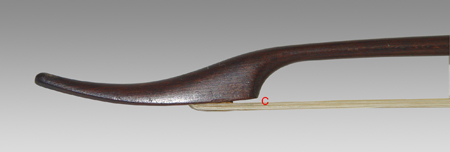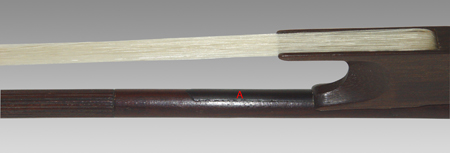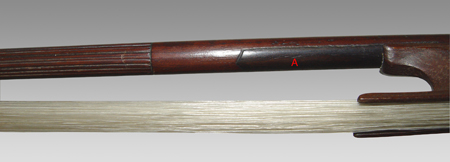
Falling in love with a bowDuring my first visit to the Museum of Musical Instruments of Bruxelles (MIM) in march 2005, I felt in love with a superb snakewood bow, the JT078, first because of its beauty and second because it may help us to understand something about playing styles of 18th century. |
 |
|
In the museum's record I wrote: "This
bows shows signs of important alterations.
Suddenly I had the idea of making some reconstructions of a bow made like the jt078 pbobably was before its alteration. |
|
|
The original bow is 686 mm long and its weight is 54,1 g while the weight of the frog (including the eyelet) is 10g. and the one of a common screw is 2,5 to 3,0 g. In MIM's collection there are other bows of similar model (jt076 and 1470) which original clip-in frogs are respectively 4,4 and 4,9g and show the same outline of this. The alteration of this bow probably added 7,5g to it, so its wight coul have been about 46.5g |
|
|
Copies of the jt078 "as is" feature a clean, rich sound and a very good balance. A very good bow to play music from the beginning of the XVIII century to the classical period. It is really easy to play even for musicians not experienced with baroque bows. Some players suggested me to move the fluting near the frog. But the reconstructions of the jt078 "as it probably was" are really something different: They join light weight and great strenght, in other words agility and power. The sound is complete, deep and rich of harmonics, very different from the version with the screw. When palyed it seems to reveal its XVII century origin. |
Ms. Mia Awouters (curator of MIM) and me on june the 6th 2006. Iin June 2006, during a visit to the MIM, copies and reconstructions of jt078 were compared to the original. |
|
 |
| The bow on the bottom has been donated to the Museum and has inventory number 06.006. It will be played in concerts promoted by the MIM. |




